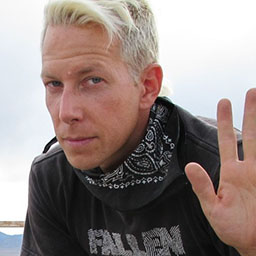Radical/Networks
October 24-25, 2015
Integrated Digital Media
MAGNET NYU Poly, Brooklyn, NY
Rob Ray

Rob Ray creates feral installations, chapbooks, videos and sound compositions for public and outdoor spaces. His interactive disorienteering guide, GET LOST! was commissioned by the Abandon Normal Devices Festival in Manchester, UK and exhibited at Conflux 2012 in New York and the Tracing Mobility festival in Berlin, Germany. From 1999 to 2008, Rob was founding curator of the DEADTECH electronic arts center in Chicago, IL, USA. Rob performs as AUGH! in the streets and as I Love Presets with Jason Soliday and Jon Satrom. Rob has launched the EXOSKELETON project in Los Angeles this year. He is on Twitter @robdeadtech
Presenting with Adam Rothstein
A History of the Future of Solarpunk Ham Radio Club
In 2016 a disaster response network of trained radio users sporting an ideal budget of $0 per person was born. While amateur radio existed through most of the 20th Century, by the 21st century it had become a bourgeois hobby for older white men. The established purpose of amateur radio in the regulations of the FCC had always been to set up a voluntary interest in radios for use in emergency (both environmental and military), but with the rise of commercial Internet radio networks (Wi-Fi) and cheap long-haul telecommunications networks, ham radio shacks became a collection of exclusive and fetishized gadgets. Younger people drifted towards the Internet.
But in 2016, emergency came calling. A group of three coastal superstorms flooded most of the West Coast, and left the population without infrastructure for weeks. A small, previously unknown group calling themselves “Solarpunks” sprang up, to fill the communication gap. Using a number of levels of financial commitment--$0, $10, and $40--they began training a culture of youth hungry for the basic skills of radio and electronics, and then letting them train others. They descended upon the rubble to pull out bits of aluminum for antennas, drying out coaxial cable, and rescuing batteries and stereo speakers from stranded vehicles. Using the disabled tech of a failed infrastructure, they began connecting themselves into a network of learning and doing. The old-guard hams had all fled to high grounds weeks ago, but the Solarpunks remained, continued their modifications and grew in numbers.
We will detail the speculative future-history of the Solarpunk Ham Radio Club and its method of spreading the use of radio with no financial investment. It took amateur radio back from a toxic commodity culture, just when it was needed most. The Solarpunks couldn’t duplicate the permanent infrastructure that needs billions of dollars in funding. But with a foothold based on a resilient jugaad rather than expensive gadgets, they were able to find a way of teaching each other, that made their network resilient in a way that money could not.





